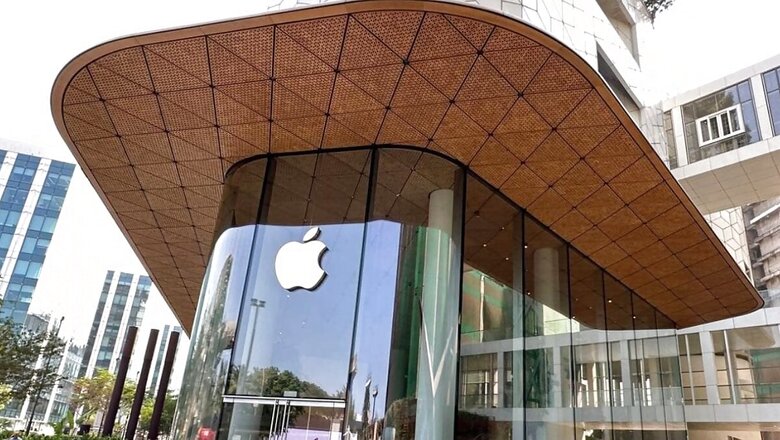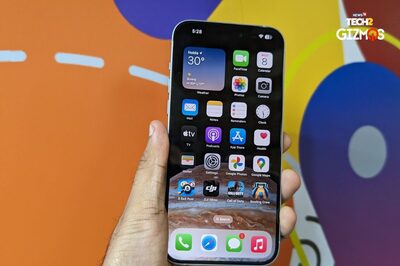
views
Apple’s quarterly results and forecast beat modest expectations on Thursday, as the iPhone maker unveiled a record share buyback program, sending its stock up 6% in extended trade. Apple increased its cash dividend by 4% and authorized an additional program to buy back $110 billion of stock. The buyback is the largest in the company’s history.
Apple’s quarterly revenue fell, but less than analysts had expected, and CEO Tim Cook said revenue growth would return in the current quarter.
The results and guidance suggest the company may be regaining its footing in the smartphone market, despite stiff competition and regulatory challenges.
The surge in Apple’s shares following its report lifted its stock market value by over $160 billion.
Apple said fiscal second-quarter revenue fell 4% to $90.8 billion, beating the average analyst estimate of $90.01 billion, according to LSEG data.
Apple CEO Tim Cook on Friday said the company grew strong double-digit in India, clinching a new March quarter revenue record amid an “incredibly exciting market”. Describing India market as a “major focus”, Cook said Apple is working on the entire ecosystem from developer to the market to operations, and that he is “very pleased” with the growth numbers.
“We did grow strong double-digit (in India). And so we were very, very pleased about it. It was a new March quarter revenue record for us. As you know, as I’ve said before, I see it as an incredibly exciting market and it’s a major focus for us,” he said in India specific call-outs during the tech titan’s Q2 earnings.
Cook further added: “In terms of the operational side or supply chain side, we are producing there; from a pragmatic point of view, you need to produce there to be competitive.”
The Cupertino-based iPhone maker has set revenue records in more than a dozen countries and regions. These include, among others, March quarter records in India, Latin America and the Middle East, as well as Canada, Spain, and Turkey.
For Apple’s current quarter, which ends in June, Cook told Reuters the iPhone maker expects “to grow low-single digits” in overall revenue. Wall Street expected 1.33% revenue growth to $82.89 billion, according to LSEG data.
Long considered a must-own stock on Wall Street, Apple shares have underperformed other Big Tech companies in recent months, falling 10% this year as it struggles with weak iPhone demand and tough competition in China.
Apple expects current-quarter services and iPad revenue to grow by double digits, CFO Luca Maestri told analysts on a conference call. The company expects gross margins of between 45.5% and 46.5% for the fiscal third quarter.
Apple faces a raft of challenges across its business. Smartphone rivals such as Samsung Electronics have introduced competing devices aimed at hosting artificial-intelligence chatbots.
On the regulatory front, Apple’s services business, which contains its lucrative App Store and was one of the few areas of growth in the fiscal second quarter, is under pressure from a new law in Europe. In the United States, the Department of Justice in March accused Apple of monopolizing the smartphone market and driving up prices.
For the fiscal second quarter, iPhone sales fell 10.5% to $45.96 billion, compared with analyst expectations of $46 billion. Apple executives said in February that the year-ago fiscal second quarter had benefited from a $5 billion surge in iPhone sales as the company caught up from supply-chain snarls during pandemic lockdowns.
Excluding that one-time phenomenon, iPhone sales were down only slightly as the Cupertino, California, company’s signature product faces stiff competition. In China, Huawei Technology has gained market share.
Cook said that iPhone sales still experienced “growth in some markets, including China.”
Apple’s revenue decline in China was not as steep as analysts expected, with Greater China sales of $16.37 billion for the fiscal second quarter that ended March 30, down 8.1% and above analyst expectations of $15.59 billion, according to data from Visible Alpha.
Apple has said little about its product plans for artificial intelligence, the technology on which rivals Microsoft and Alphabet’s Google are placing huge bets. The company started ramping up research and development spending last year, and Cook said the company has spent more than $100 billion on R&D in the past five years.
“We continue to feel very bullish about our opportunity in generative AI and we’re making significant investments,” he said. “We’re looking forward to sharing some very exciting things with our customers” at events later this year, Cook said.
As it races to bring AI into its products, Apple’s massive buyback program may appease investors who have been bruised by its sinking stock price.
“It’s certainly a great time to resort to this strategy as, on the one hand, the stock remains relatively fairly priced, and, on the other hand, it needs to garner solid support for a structural shift that may very well take several quarters to play out,” Investing.com analyst Thomas Monteiro said in a client note.
Apple’s quarterly earnings per share were $1.53, above Wall Street estimates of $1.50, according to LSEG data.
Sales in Apple’s services segment, which also represents Apple Music and TV offerings, rose to $23.87 billion, above analyst expectations of $23.27 billion, according to LSEG data.
Analysts had expected Mac sales to decline in the fiscal second quarter, but they instead grew to $7.5 billion, compared with estimates of $6.86 billion, according to LSEG data.
“They were really driven by the strength of the new MacBook Air that’s powered by the M3 chip,” Cook said. “About half of our MacBook Air buyers during the quarter were new to the Mac.”
The company’s sales in the iPad segment declined to $5.56 billion, below analyst expectations of $5.91 billion.
In the company’s wearables segment, which represents sales of Apple Watches and AirPods headphones, sales fell to $7.91 billion, compared with analyst estimates of $8.08 billion, according to LSEG data.
(With Inputs From Agencies)




















Comments
0 comment